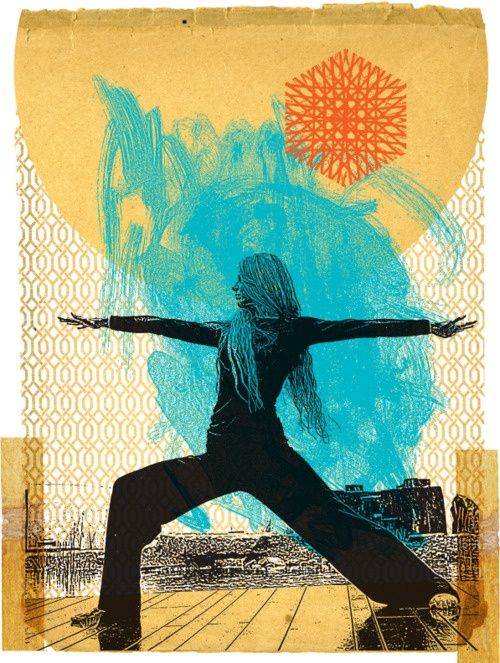Yoga is 99% practice, 1% theory. Sri Krishna Pattabhi Jois
In my Yoga News last month, I asked you what you would like me to write about in my future blog posts to help with that ‘tiny’ 1%. I am answering Tony’s request today, reviewing the health benefits of one fundamental standing pose, Warrior 2, and a little more. Future posts will also cover Warrior 1, Downward Dog and Cobra! Virabhadrasana 2 – aka Warrior 2 – is one of the poses that you are almost guaranteed to practice in a Hatha Yoga class. It focuses on building leg strength and stamina and provides a way to stretch the hips, groin, and legs as well as chest and shoulders. It is an effective way to build a feeling of inner strength and power. As you practice this pose on a regular basis, you will grow in your ability to face daily battles with ease and grace.
All stories from Hindu mythology have
a moral that adds value to our life…
Virabhadrasana 2 was named after Virabhadra, a fierce warrior and incarnation of Shiva. The term asana means pose. The myth states a powerful priest hosted a great sacrifice but did not invite his youngest daughter, Sati, and her husband, Shiva, the supreme ruler of the universe. Sati found out, visited the sacrifice and began arguing with her father. Distraught from the argument, Sati walked into the fire and killed herself. When her husband heard of her death, he became enraged and created Virabhadra, a ferocious warrior who avenged the death of Sati. The three Warrior Poses spring from this myth:
Virabhadrasana 1 – Warrior arrives with swords in hands, breaking through the earth from below.
Virabhadrasana 2 – Warrior sees enemy and focuses attention, preparing for battle.
Virabhadrasana 3 – Warrior moves swiftly and attacks the enemy.
The benefits of Virabhadrasana 2
Stretches and strengthens arms, legs, ankles, and hips.
Stretches chest and shoulders.
Stimulates abdominal organs.
Increases stamina and balance.
Relieves backaches (especially through the 2nd trimester of pregnancy) and sciatica.
And also…
By opening the chest and shoulders, it improves breathing capacity and increases circulation throughout the body. Hence it makes it very beneficial for those with sedentary or desk-bound jobs!
It releases stress in the shoulders very effectively in a short span of time.
It is extremely beneficial in case of frozen shoulders.
How to practice Virabhadrasana 2?
> Start in Tadasana (Mountain Pose) and take your legs wide apart (at least 3-4 feet).
> Turn your left foot in by about 15 degrees and right foot out by 90 degrees.
> Breathe in and lift both arms sideways to shoulder height, palms facing down.
> Breathe out and bend right knee. Ensure that your knee does not overshoot the ankle.
> Turn your head to the right as you look over the fingers of your right hand.
> As you settle down into the posture, stretch your arms further and keep breathing.
> Hold the pose for 30 seconds to one minute. When you are ready, inhale and come up.
> Reverse your feet and repeat.
Tips
Practicing Virabhadrasana 2 correctly requires concentration on various points of alignment. Keep the following information in mind when practicing this pose:
• Work on getting the foot and leg placement first. Build the pose from the ground up.
• Make sure your front knee stays aligned with your front ankle. Do not allow the knee to drift inward, this can strain the knee joint. Instead, imagine it slightly moving out toward the baby toe.
• Keep lifting the inner arch of your back foot while pressing the outer edge down.
• Keep your torso/spine straight and perpendicular to the floor, do not lean towards your front leg.
• Keep your focus on a single point.
• Envision the power of the warrior Virabhradra moving through you as you hold the pose with grace and peace. Find and connect with your own warrior strength!
Precautions
Use caution when performing Virabhadrasana 2 if you are currently experiencing diarrhea, high blood pressure, vertigo, hip or neck pain.
Modifications & variations
1) If your hips are very tight, shorten your stance and straighten your front leg to a degree that is comfortable as you work on gaining flexibility.
2) If you have a shoulder injury or if you are still building upper body strength, place your hands on your hips.
3) If you are experiencing neck pain, do not turn your head and look over your front arm as you are in the pose. Instead, keep facing forward and in the same direction as your chest to reduce strain.
4) If you are experiencing hip pain or feeling challenged in the pose: use a chair for support. Straddle the chair and face the chair back. Drop into the pose by bending your left knee and straightening your right leg. Bring your buttocks close to the seat of the chair without actually touching the chair. Hold this pose for as long as you can and if you need a rest, slowly lower yourself onto the chair until you are ready to continue again.
More than just a physical posture, Vira 2 increases your ability to concentrate. As you hone your gaze, you direct your mind clearly and with intention. Distractions disappear and your energy becomes powerful and focused. Happy practice yogi(ni)s, I hope this helped! :-)

